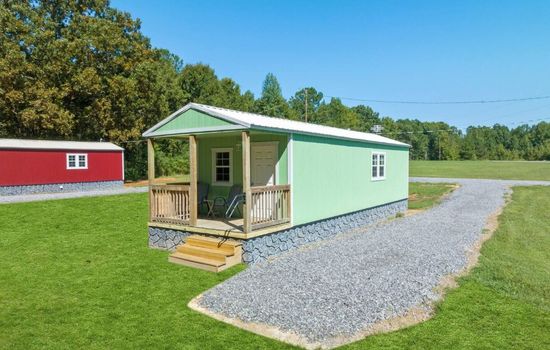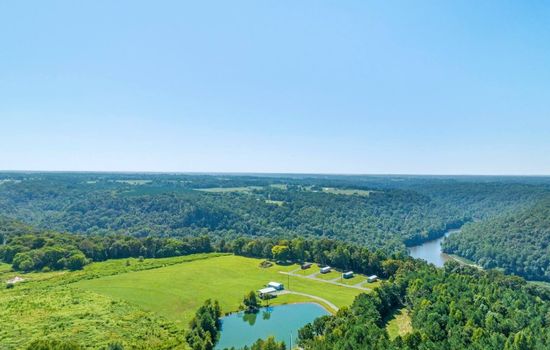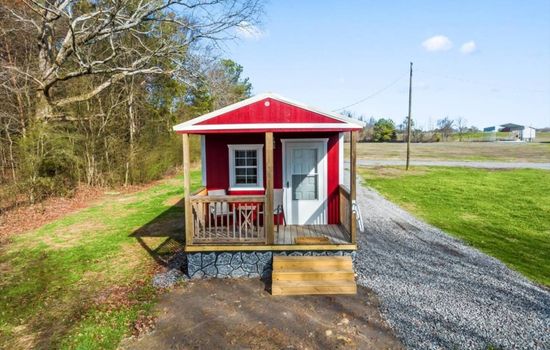The Visitor Center at Russell Cave National Monument is open daily from 8:30 AM to 4:00 PM, except for Thanksgiving, Christmas, and New Year’s Day.
There is no entrance fee at Russell Cave National Monument; it is free to the public year-round.
From Chattanooga, take US-72 W into Alabama, turn right onto Co Rd 75, then Co Rd 98, and immerse yourself in ancient history and natural beauty.
There is a sizable parking lot near the visitor center, accommodating cars, smaller RVs, and motorcycles. No overnight parking or fees.
Accessibility & permits
Emergency
- Cell service availability:None
Information not accurate?
Help us improve by making a suggestion.
In the northeast corner of Alabama, Russell Cave National Monument stands as a testament to the rich cultural and natural history of the region. This archeological site, with its extensive record of prehistoric cultures spanning over 10,000 years, is a unique destination for those seeking to immerse themselves in the past.
The cave itself is not a traditional subterranean passage but a rock outcropping that served as a shelter for prehistoric inhabitants. The site is surrounded by a landscape that remains remarkably unchanged since the days of its ancient occupants. The area is home to a variety of wildlife, including deer, turkey, black bear, and small animals like squirrels and raccoons, which were once hunted by the cave’s residents.
Visitors can explore the cave either on their own or with a guided tour led by a park ranger. The short, steep trail leading to the cave is a precursor to the main attraction, where artifacts such as spear and arrow points, pottery shards, and animal bones reveal the lives of the people who once called this place home.
For the more adventurous, a strenuous uphill hiking trail offers a challenging workout with scenic views, though it does not lead to other historic sites. The nearby town of Bridgeport provides additional attractions, including the Bridgeport Railroad Depot Museum.
While Russell Cave National Monument may not host grand summer concerts or ranger-led canoe tours, its serene and historically significant environment makes it an compelling destination. The on-site exhibit and museum at the Visitor Center provide a thorough understanding of the site’s archeological importance. This monument is a place where the past and present converge, offering an intimate and educational experience that resonates deeply with visitors.
- Area (mi²)
- 1
- Established year
- 1961
Top 3 Facts about Russell Cave National Monument
This ancient rock shelter, carved through limestone, is the oldest regularly inhabited in the eastern U.S., with evidence of human use spanning thousands of years, including Paleolithic spear points and stone tools, and yielding approximately two tons of artifacts.
This verdant oasis is home to over 130 bird species, including those along the North Alabama Birding Trail. The cave stream hosts sculpin fish, while the surrounding landscape is inhabited by white-tailed deer, foxes, and rabbits. Eight bat species, such as the big brown and northern long-eared bat, find refuge here. Copperheads, timber rattlesnakes, and kingsnakes slither through the underbrush, adding to the rich biodiversity of this natural haven.
In the heart of the Cumberland Plateau, ancient carbonate rocks, formed over 300 million years ago, have been sculpted by millions of years of groundwater dissolution, creating a labyrinthine cave system. The area is dotted with karst features like sinkholes and springs, and the cave’s upper levels, with deep, canyon-like cross sections, reflect a vadose environment shaped by subterranean streams. The limestone, a result of transformed carbonaceous deposits, stands as a testament to geological history.【Source: 】
Family programs
- Junior Ranger
- Ranger-led Tours
- Self-guided Tours
- Workshops & Hands-on Activities
- Living History & Cultural Demos.
Travel Tips
Plan Ahead
Visit in spring for wildflowers; allow an afternoon to explore. Park at the welcome center, take the easy boardwalk to the cave, and prepare for a strenuous nature trail. Bring water, snacks, and hiking shoes. Limited dining options nearby.
Pack Appropriately
Pack layers for variable weather, sturdy footwear, and a backpack with essentials like water, snacks, map, first aid kit, and a headlamp for evening hikes. Bring camping gear if staying overnight. Check the season for specific needs like warm hats or insect repellent.
Respect Wildlife
Respect the habitat by staying on marked trails, avoiding disturbance of wildlife, and not touching or removing plants. Be mindful of nesting seasons and avoid loud noises. Leave no trace and take all trash with you. Enjoy the unique flora and fauna responsibly.
Stay Informed
Stay informed about weather, fire restrictions, and trail conditions. Exercise caution on trails, near ledges, and around water. Carry a first aid kit and know basic first aid. For emergencies, call 911 or park authorities at 256-495-2672. Travel with a companion and stay on marked trails.
Seasons
In spring, as temperatures rise to the 60s and 70s, vibrant wildflowers bloom and birds migrate. Join a lantern hike or tools demonstration amidst mild weather, ideal for outdoor exploration. March to May, experience nature’s awakening in a lush, diverse habitat.
Visit in summer for warm temperatures (80s-90s°F) and humid weather. Enjoy Tools and Weapons Demonstrations, lantern hikes, and nature walks. Witness vibrant wildflowers and diverse birdlife, including summer tanagers and yellow-billed cuckoos. Ideal for outdoor enthusiasts despite the heat.
Visit in fall, when temperatures range from 50 to 70°F, for comfortable hikes and scenic walks. Enjoy the vibrant foliage and possibly the annual Native American Heritage Month events, celebrating prehistoric cultures amidst the lush autumn landscape.
Visit from December to February for a serene winter experience. Temperatures range from 30°F to 50°F, with crisp air and fewer crowds. The short, scenic walk to the cave entrance is particularly stunning with moss-covered trails and winter foliage. Ideal for those seeking a quiet, immersive historical and natural retreat.
Information not accurate?
Help us improve by making a suggestion.
Where to stay
Frequently Asked Questions
Ready to dive into what Russell Cave National Monument has to offer? Let’s tackle some of the burning questions you might have as you plan your visit!
-
The closest city to Russell Cave National Monument is Bridgeport, Alabama, which is also near Chattanooga, Tennessee, just less than an hour’s drive away. Russell Cave is located at the foot of Montague Mountain, part of the Cumberland Plateau, just west of Bridgeport.
-
Dogs are allowed on the nature trail and the boardwalk, but they must be on a leash no longer than 6 feet. They are not permitted in the museum. Dogs can join their owners year-round during the day in all seasons.
-
Parking is free here. There are no fees for visiting or parking, including for campers, trailers, motorhomes, and other vehicles. Donations are welcome but not required.
-
Guided tours of the cave are no longer routinely offered, but visitors can request a guided tour if staff is available. The main activities include visiting the museum, watching a park film, and hiking the trails outside the cave area. The Gilbert H. Grosvenor Visitor Center is a key stop for information and activities.








